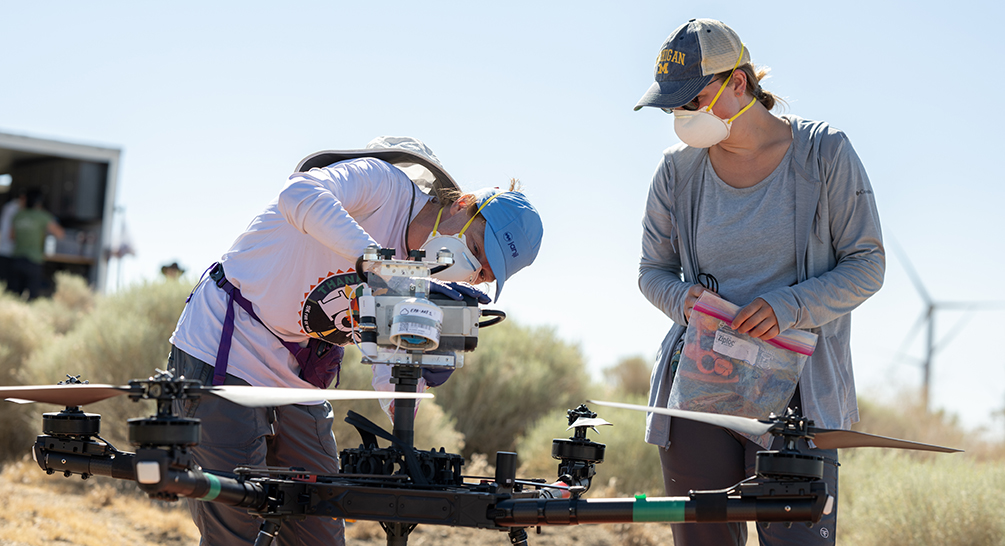Connecting climate change to fungal diseases

Q&A with Jennifer Head
Assistant Professor of Epidemiology
Jennifer Head investigates how our changing climate has led to emergence and transmission of infectious disease with a particular focus on primary fungal infections.
Head, an assistant professor in the Department of Epidemiology at the University of Michigan School of Public Health, applies mathematical and statistical models to understand the transmission dynamics of zoonotic, emerging and environmentally mediated diseases.
Two of the epidemiologist’s main research interests are blastomycosis, a rare fungal infection that usually affects the lungs, and coccidioidomycosis—or more commonly known as Valley fever—a disease caused by a fungus that grows in the soil and dirt in some areas of California and the southwestern United States
Head, who grew up in Cincinnati, has a PhD in Epidemiology from the University of California, Berkeley and a master’s degree in Global Environmental Health from Emory University. She earned a bachelor’s degree in Chemical Engineering from Washington University in St. Louis, where she also minored in Environmental Engineering and Spanish.
Is there anything in your past that helped lead you to your interest in public health?
I originally studied engineering because I was interested in the development of sanitation and water infrastructure for better health in a global context. I worked at the Washington University in St. Louis chapter of Engineers without Borders, where we partnered with a school for children who were blind in Mekelle, Ethiopia. Together with the school, we worked on designing and building a water tower and distribution system for the approximately 100 children who boarded at the school. After earning my bachelor’s degree, I did a nine-month Fulbright Research Fellowship in Ethiopia that focused on addressing vitamin A deficiency as a major cause of childhood blindness in Ethiopia.
What drew you to study epidemiology?
I got my start in engineering, but when it came time to graduate, I realized that while I loved the quantitative work of my engineering degree, my passion came from working in the field of health. Realizing that I might not want to be an engineer, I turned to an undergraduate professor of mine for support on what to do next. He suggested I consider public health and told me that public health was a highly quantitative field—something I had never realized before. I had never even heard of epidemiology, so I applied to get an MPH in Global Environmental Health from Emory University. I deferred admissions for a year to do a Fulbright Fellowship in Ethiopia. Only while getting my MPH did I really understand that epidemiology was a field! I turned toward epidemiology for future study because it felt like the fundamental backbone of public health where I could learn study designs and analyses that would be relevant across many disciplines.
I hope that over time I will expand my work to be more global again, but now I feel that this is the area where I can best contribute to the health of the public and advance scientific understanding.”
— Jennifer Head on fungal infections
Where did you work before you came to Michigan? What attracted you to work at Michigan Public Health?
During my Fulbright Fellowship, I wanted to address vitamin A deficiency as a major cause of childhood blindness in Ethiopia. As part of this work, I worked with food manufacturers, university departments and nutrition-focused NGOs to understand and address barriers toward micronutrient fortification of oil and wheat flours. Local technology for fortification emerged as a theme that presented a barrier, so I worked with local engineers and manufacturers to build and test some mixing equipment locally. I continued to work globally in the field of nutrition as a survey consultant for Save the Children in Lao PDR.
Prior to my doctoral work, I did a two-year global health fellowship at the Centers for Disease Control and Prevention, where I was the epidemiologic liaison to the CDC office in Kazakhstan. My immediate supervisor was a veterinarian, and I was involved in several One Health projects, including doing a serosurvey of sheep, cattle and livestock workers for evidence of infection with Crimean Congo Hemorrhagic Fever—an emerging tick-borne disease with high fatality. I was also involved in work seeking to understand the role of wildlife reservoirs for Zika Virus in Brazil, Peru and Colombia. This work made me especially interested in zoonotic diseases and the intersection of human, animal and environmental health.
During my doctoral work at the University of California, Berkeley I loved being at a large public institution that had close ties to state public health. Michigan was very attractive for similar reasons, being among the best public health schools and having partnerships with the Michigan Department of Health and Human Services (MDHHS) and other community organizations. Climate and disease work is inherently interdisciplinary, so I was also drawn by Michigan’s “excellence at scale.”

What is your main area of research and what drew you to work in that area?
I am interested in how climate and other environmental changes are changing where environmentally persistent pathogens live and how they spread. I’m generally interested in emerging, zoonotic or vector-borne pathogens. Right now, I am especially interested in environmentally transmitted fungal pathogens that can make otherwise healthy individuals sick, including Valley fever, histoplasmosis and blastomycosis.
My interest in the intersection of environmental, human and animal health has been a theme since I was younger. When my sister and I were kids, my family would take road trips out West, and I fell in love with the outdoors. I’m happiest when I’m outdoors, so I have long understood that the environment has a profound influence on human health. With climate change and other anthropogenic disturbances to the environment, it’s also time to be concerned with the health of our environment.
My involvement in fungal disease work was more serendipitous. The lab I joined for my PhD had just partnered with the California Department of Public Health to understand why Valley fever—an emerging fungal infection—was increasing so dramatically in California. As I got involved in that work, I realized how complex and mysterious the transmission of the Valley fever fungus (Coccidioides) is. As an example, we still don't know basic information such as whether the pathogen relies on rodents to survive in the soil, how far spores travel, the number of spores needed to cause infection, nor how many people have immunity towards this disease.
There is so much that we don't know about Valley fever and other fungal diseases, and not many people are studying the epidemiology or environmental ecology of human pathogenic fungi. I’ve continued to be interested in fungal diseases because there are a lot of mysteries that remain to be solved, and I feel positioned to be part of solving them. At the same time, I can see that my work has had some impact on spreading awareness about disease transmission and hopefully helping to motivate vaccine funding. I hope that over time I will expand my work to be more global again, but now I feel that this is the area where I can best contribute to the health of the public and advance scientific understanding.
